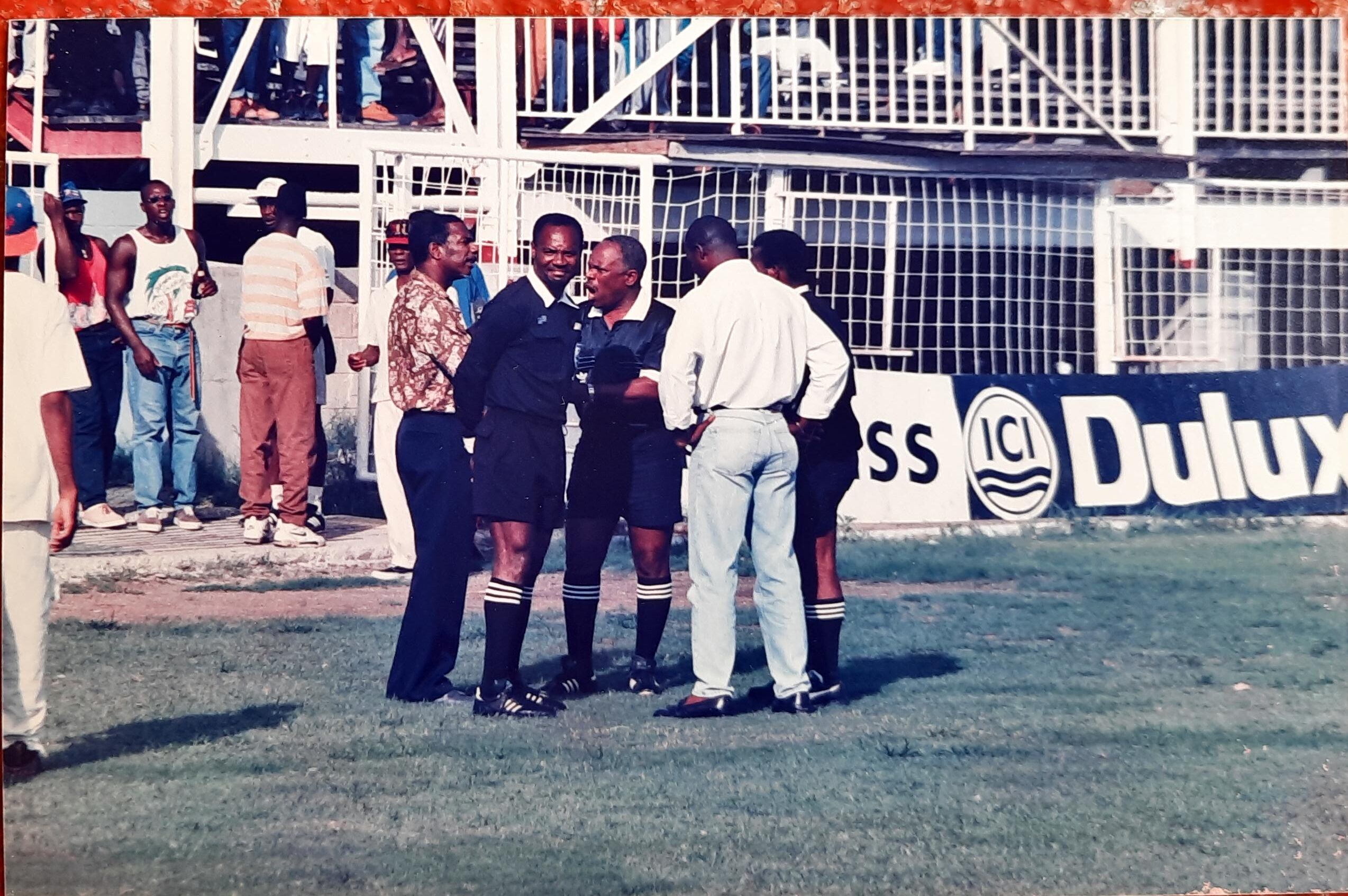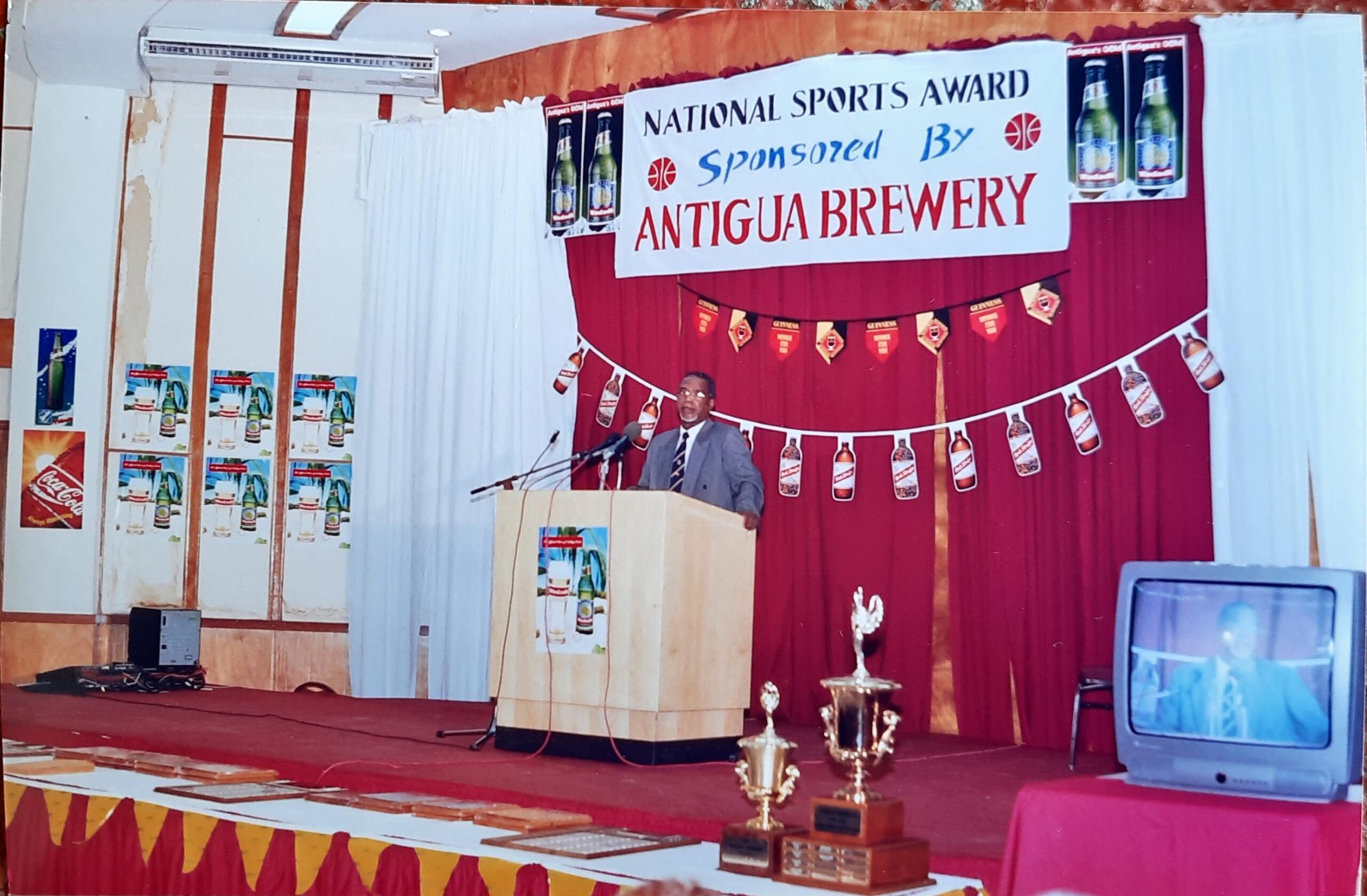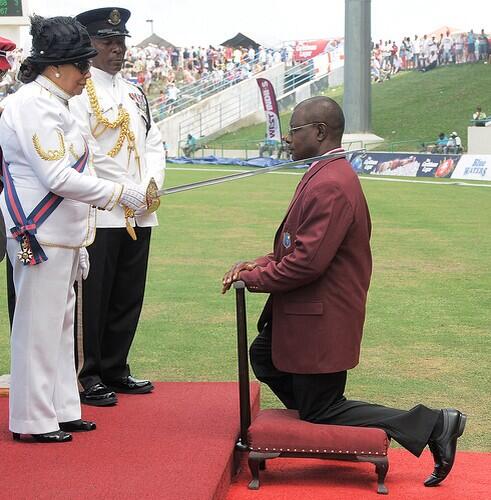By Colin James
Patrick Cleofoster Whyte was a pantheon of sports in Antigua & Barbuda, the Caribbean and internationally.
He strode the sporting landscape like a colossus. Never fearful to express his view forthrightly to authorities and athletes; reasoned and compassionate in his thoughts and actions; and fair-minded and unbiased in applying the rules and regulations and laws of the game.
He will be remembered in the legion of Antiguan sports development as one of those who left an indelible mark and contributed immensely in taking it to another level.
From been a member of the sports committee who charted the pathway to stardom for Sirs Viv Richards and Andy Roberts – two of the Antigua & Barbuda’s great cricket luminaries – to coordinator of school sports – initially cricket, football, netball and athletics – from his perch at Church St, and later as Director of Sports, from his office at Paynters, Pat Whyte played an indelible role in the transformation sports between the 1970s to early 2000s.
He served par excellence as an administrator, manager, umpire, commentator, statistician, advisor and motivator to all and sundry.
When his day at the office was over, Pat Whyte did not pack up and drive home; his next tour of duty was to walk across East Street (now Independence Avenue) to the cathedral of sports excellence – the Antigua Recreation Ground – to watch Premier Division football match or to conduct some administrative duty for the general upkeep of the venue, a meeting with the football fraternity, the umpires’ body or the staff at the ARG.
He was always present and ready to serve, whether it was with the Antigua & Barbuda Football Association executive as second vice-president, as manager of the national senior or youth teams or umpiring.
I heard and knew of Pat Whyte as an early teenager before he made a profound impression on my tenure as a sports administrator and coach, as well as a journalist and commentator.
Nonsense in approach; wary and witty was his articulation and studious in his application and dedication to duty – there are not many who could have and may not be able to emulate him.
My first knowledge of this affable individual was when my parents (the late Alfred ‘Colo’ and Tessie James) encouraged and insisted that I listened to the sports report on ABS Radio from the mid-1970s when the booming voice of Pat Whyte would permeate the airwaves about 7:30am and pm.
His affectious voice was unmistakable and his depth of insight and clarity made it pellucid to learn and understand.
I remember vividly walking down Michael’s Mount after a football game and a car passed by and someone in my company said there goes Pat Whyte. You can imagine how disappointed I would have been only to have got a glimpse of him.
Over the next few years until I finished my stint at the Antigua Grammar School in 1984, the name Pat Whyte was synonymous with all-things sports. When I participated in school football, cricket and track, his personality cast a positive shadow. His name was on the tip-of-the-tongue of every athlete because we knew what he represented and stood for. As student-athletes we had to collect and return gear and equipment from the sports department for matches, and provide the scores and results from the matches, if the umpires and referees were tardy.
Through the instrumentality of our football and cricket coach, Clancy Mack, my appreciation and admiration for Pat Whyte’s work blossomed.
Sports reporter at ABS Radio
After completing AGS in 1984, I began a two-year stint at the government-owned Antigua Broadcasting Service that September, compiling and reporting the sports reports, with the assistance of now Ambassador Clarence Henry, and my late classmate, Raymond O’Keiffe.
One of my first assignments was to cover the opening of the school’s football season, and obviously a first-hand opportunity to interview Pat Whyte during the curtain raiser match. There was a moment during the interview that’s etched in memory. As he was answering a question posed as the match was in progress, a goal was scored and the cheers of the students of the school drowned his words. He instantaneously went silent and looked at me. In the blink of a second or two, this novice, rookie reporter had to respond. I somehow managed to scramble a few words to say: “well, one of the teams has just scored a goal and their supporters are rejoicing.” Not the exact words but somehow close. It was my first lesson of how to handle the unexpected in doing a pre-recorded interview.
For the next 24 months, Pat Whyte was a source of information and results for my sports reports and programmes. We had a telepathic understanding. Religiously, on or about 6:30pm, I would receive schools’ football results via telephone and they were read precisely based on the fixtures. The same was true for, for schools’ cricket matches with the top performers highlighted.
If there was an issue or a controversial matter stirring up locally, regionally or internationally, Pat Whyte’s counsel or opinion was canvassed. If he thought his comments conflicted with his substantive post – government or voluntary – he would speak-off-the-record.
He would offer advice on how to traverse tricky situations while instilling confidence and belief in my work.
Commentator for Premier Division football matches
It was a commentator’s dream to have Pat Whyte as your co-commentator while doing live commentaries. Reluctant at first because his comments may be construed wrongly, whenever he took up the microphone, it was a joy to behold. Descriptive and analytic (and not afraid to be critical) were the hallmarks of his trade.
He blended those with wit and satire: “Here comes the goalkeeper and he’s caught in no-man’s land as the goal-scorer slots the ball into an empty,” leaves nothing to the listener’s imagination.
What about this one: “And the defender is caught between the Devil and the deep blue sea as he attempts to clear while under pressure from the attacker and rather passing to his teammate loses possession and unfortunately made a mistake in his team conceding a goal.”
Then there is a comment about no forgiveness for the team who lost a game which they should have won: “Well, I don’t know why the players are crying because they only have themselves to blame. They should be given a stone to dry their tears.”
There are countless others but those cited will suffice.
Unsuccessful attempt to work with him
So impactful was his influence – and my burning desire to learn and pick his brain – that I asked him to use his good offices to assist me in getting a job in the sports department in 1985. He agreed that I would have been as asset to the team who comprised Sir Reginald Samuel, then Director of Sports, Danny Livingstone, the outstanding cricket and football player and coach, and the ever-dependable, Stanfield ‘Shipwreck’ Joseph, but the higher authorities didn’t concur. However, that did not put a strain on our booming relationship.
Invitation to serve as assistant manager of national football team
It blossomed further on another level. In April, 1989, I had just returned home from a tour of St Thomas, USVI, as manager of the Attackers Football Club, when my mom informed me of an urgent phone call from Pat Whyte and I should return the call soonest. Unaware of the content of the call, I was no doubt apprehensive to return it, but I did. To my wildest expectation he summoned my services to be his assistant as manager of the national senior team for the inaugural Shell/Umbro Caribbean Cup, the region’s top competition. Overwhelmed by the invitation I had reciprocated after I took him out of his comfort zone a few years earlier to commentate.
With coaches Clancy Mack, assisted by Micah Samuel and Rowan ‘Porridge’ Benjamin, also Fernando Abraham (injured at the time), the national team comprising: Everton ‘Batow’ Gonsalves, Mervyn ‘Wiser’ Tittle, Sean Deterville, Andy ‘Job’ Christian, Ivor ‘Ninja’ Luke, Daryl Greenaway, Dale ‘World B’ Edwards, the late Eustace ‘Barba’ Ferrance among others, and the emerging Quentin Clarke, set about to make its mark on the regional scene.
Memorably, the campaign started successfully with a 1-0 win over Jamaica (before they were christened ‘The Reggae Boyz’) at the ARG, with Gonsalves (now president of the ABFA), the scorer. Other results didn’t materialise as expected, including a 1-0 loss to Guadeloupe when a draw would have been enough to reach the finals of the tournament.
By that November, Pat Whyte had given me the reins to manage the national team just aged 23. Two months earlier, Hurricane Hugo had left its mark on the sub-region and the Leeward Island leg of the then OECS tournament was played in St Kitts. I recalled he advised me to ensure all immigration forms were filled out prior to the team arriving at the airport for ease of checking-in; not to give the players permission to go sightseeing or go shopping before the matches concluded.
“Don’t allow them to tell you that they want to go see the damage the hurricane left,” he admonished me. “Some will tell you they want to go shopping to pick a few souvenirs, they can do that after the tournament,” he cautioned.
That was not my first opportunity to benefit from Pat Whyte’s influence as a manager. As a reporter I toured with the national youth in 1985 for a tournament in Martinique. A squad who included Tittle, Derrick ‘Pretty Boy’ Edwards (as goalkeeper then), my brother, Vorn ‘Popty’ James, Mitchel Thomas, Avery Jonas, brothers Aldrin and Gerard ‘Cougar’ Isaac, ‘Brigo’ Benjamin, Terry ‘Shifa’ Browne and George ‘Lamming’ Ralph. I arrived a day or two after the team left and when I got to the hotel I went to his room and was immediately struck by organisational acumen. All the playing kits were neatly assembled ready for the players.
National Sports Awards
I would frequent the sports department regularly, and virtually ‘moonlighted’ in the 1990s while I freelanced as a journalist. Our many debates on how to move sports forward caused him to invite me to serve on the committee to formulate the national sports awards. I was more than eager and enthusiastic to make my contribution as I figured he felt I could have brought value to the deliberations. The committee’s recommendations received Cabinet approval and so the sports awards were inaugurated in 1992.
The ceremony quickly became a staple on the sporting calendar, and although the top performing sportsman and sportswoman were recognised annually, Pat Whyte insisted that discipline and the propensity to become a role module be enshrined in the criteria.
There was a surreal moment during the 1999 ceremony which left the patrons stunned. At the podium, while apologising for the absence of then Prime Minister Lester Bird, because he had conveyed earlier that he was ill, it came as a “shock”, when the giant-size figure of Sir Lester ‘ghosted’ into the Royal Antiguan hotel ballroom. The consternation in the audience, and bewilderment on Pat Whyte’s face, spoke volumes. Needless to say, he quickly retorted and ‘welcomed’ Sir Lester to present the top awards.
ARG resurfacing
Many would say Pat Whyte’s crowning moment was his supervisory role in the herculean task of resurfacing the outfield at the ARG to host the West Indies v England Test match in March, 1998. It was a race against time to get the job done as the importation of Bermuda grass from the US meant there were delays. But Pat Whyte assembled a team of capable workmen, professionals and advisors to marshal the operation, and against the cries of critics and sceptics when Chickie’s Hi-Fi boomed Baron’s “green, green grass of home”, a mere week before the Test bowled-off, the pride and joy of the nation was palpable.
Umpiring
Pat Whyte’s umpiring prowess was stymied and blighted by myopic regional administrators who could fathom that the men-in-the-white coats from the sub-region were just as competent , and even better than those in the so-called ‘bigger’. That snub did not deter nor discourage him from educating and training a future generation of umpires to include Clancy Mack who officiated in Test and One-Day Internationals.
His stictudeness to correctness caused him to wail against commentators who refer to the ‘pitch’ as the ‘wicket’.
“The wicket is the three stumps. The pitch is 22 yards between the wickets,” he retorted.
Negative comments
Players and administrators who didn’t respect his selection decision or his views would poke negativity at his name by referring to him as ‘Pat-blight’, but later in life they would confess that what he did or said would have manifested in their lives.
They say many are called but few are chosen. Pat Whyte chose sports as his vocation after a stint as an insurance salesman.
He was selfless and fearless. He served generously and willingly. He answered his call and gave his all.
Rest In Peace, P. Whyte!
Gone, never to be forgotten!



